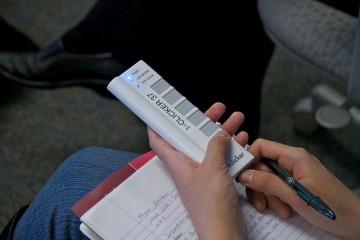iClickers are handheld and wireless elearning devices in which students can respond to questions by the click of a button to answer in class quizzes and polls. With its real time response capabilities, the results from the assessment can be tracked instantly and displayed back to the class. Lessons can be customized with this feedback as teachers get a feel for whether their students are understanding important concepts. There are many related technologies and strategies to support real time engagement and all-class response.
There is potential value for student response systems (SRS) to support active engagement in the classroom. As teachers, we need to consider the benefits and the potential drawbacks of different systems before incorporating. By keeping in mind that the efficacy of any student response system depends on the quality of the questions and how we use the system, we can make a more informed selection. There has been research that greater efficacy and increases in student learning are achieved when an SRS is coupled with socio-constructivist methods. The use of these systems along with student discussion and pair share also leads to greater student satisfaction.
See this ‘educause’ article to get you started thinking about using iclickers or other SRS as part of an active learning approach. The notion that engaging the ‘backchannel’ during lectures adds an active component to this more passive form of teaching is taking hold with the growth in BYOD (bring your own device) and the need to start harnessing the value of this trend. Check out ‘TodaysMeet’ or Slido. Many local school districts (Coast Metro) have adopted Office 365 as the district standard. A Backchannel chat is incorporated into their learning tools (TIP: consider ‘moderating’ your chat to ensure posted content is appropriate).
See this handout Sandbox_iClicker_Mar2015 update for more information, research notes and ideas.
Did you know that there are two class sets of iClickers (and controllers) available on loan through the Scarfe Education Library for instructors and teacher candidates? All you need is the clicker set (which includes a ‘base station’) and a computer hooked up to a projector. iClickers can support interaction, formative and summative assessment in any classroom – regardless of age level or size – and are relatively simple for teachers and students to use.
Sandbox iClickerQuickStart guide
Visit: http://elearning.ubc.ca/toolkit/clickers/ for FAQ, step by step setup and more!
Idea – for some ‘proactive’ classroom management, hang or display signs showing the ‘choices’ related to the letters on the clickers.
Here’s a chart comparing 5 student response systems you might want to try:
Backchannel/ Informal Assessment Tools Comparison Chart
iClickers are just one type of Student Response System (SRS). There are many alternatives to iClickers to support engagement, interactivity and assessment. A few of my favourites (all are free and compatible across platforms):
Try: ‘Plickers’ – The very low tech, high tech version of an SRS. All you need is some downloadable class cards and one smartphone. The students hold their cards up based on their answer (A, B, C, D), the teacher scans the cards from anywhere in the classroom using a smartphone, tablet or ipad, or even the gym, and the responses are automatically entered. The class can view a graph of responses if you connect your computer to a projector and you can easily see responses.
or Try: Socrative – a free online digital technology that can be used with any handheld or personal computing device (as long as there is internet access). One of the benefits that I see of Socrative over iClickers is the ability to have students answer questions with short answers. Socrative allows the instructor to create quizzes and games that can be saved and re-used or ask questions ‘on the fly’ orally or in writing. It even has a built in ‘exit slip’ for students to complete. Socrative, like iClickers and Plickers, allows the instructor to view and save data.
Another alternative for in-class polling is PollEverywhere. A poll (of one or several questions) can be set up as needed or in advance and made live. Students respond via text messaging or online.
Kahoot is a ‘game-based’ student response system complete with sound effects that purports to ‘make learning awesome’. Try it and see for yourself. Remember though, it’s about the questions you ask and the interactivity you provide more than the app! Students respond using their computers.
A Paid option that Alixa (IB-PYP teacher candidate) introduced me to today that I’ll be checking out is ‘Lecture Tools’. The teacher sets up an account. Each student then needs to set up an account using his/her email (a limitation I think and privacy issues to consider if you use this). The teacher can upload PowerPoint or Evernote slides and integrate quizzes (including short answer) into their presentation. Each student can take notes on the slides and answer questions as they appear in the presentation (live on their own screen). Theirs notes and responses are saved for them for the next time they login. They can even see a graph of responses and view all short answer responses. Terrific for studying!


